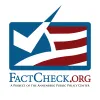Take a look inside 4 images
FactCheck.org
Pros: Straightforward to navigate and search site; covers timely issues; shows that bias in the media crosses governmental party lines.
Cons: Primarily U.S. focused, and there are no additional resources.
Bottom Line: FactCheck.org can help students stay up to date with current events and developments.
How Can I Teach with This Tool?
FactCheck.org has a simple and focused goal: to combat misinformation and fake news. Teachers can use the site to help students find fact-checked perspectives on current events or to learn how to analyze and support the truthfulness of a claim.
FactCheck.org publishes a wide range of analyses of different false claims about current news stories (primarily with a U.S. focus). Each one comes with a "quick take" that includes a very short summary of the claim around an issue and a brief explanation of the truth. Keep reading, though, and you'll find an in-depth examination of the story, the claims, and the facts. These "full stories" come with links to other sites and an extensive list of sources including government groups and news sources. Teachers can use the site to help students sift through many of the misrepresentations they come across in their regular media use.
For classes that really want to work on media literacy, FactCheck.org can serve as a guide for helping students do the same kind of analysis themselves. Using one of the site's posts as a mentor text, teachers can help students learn to corroborate sources, check claims, and back up their own opinions with evidence.
There's also a news media literacy game built in to the site, NewsFeed Defenders, which teaches students how to detect misinformation. There are additional resources for the game, along with learning objectives and a teacher extension pack.
Funded by the Annenberg Public Policy Center from the University of Pennsylvania, FactCheck.org also shows that bias in the media crosses party lines -- a useful attribute if your class is polarized around certain issues.












